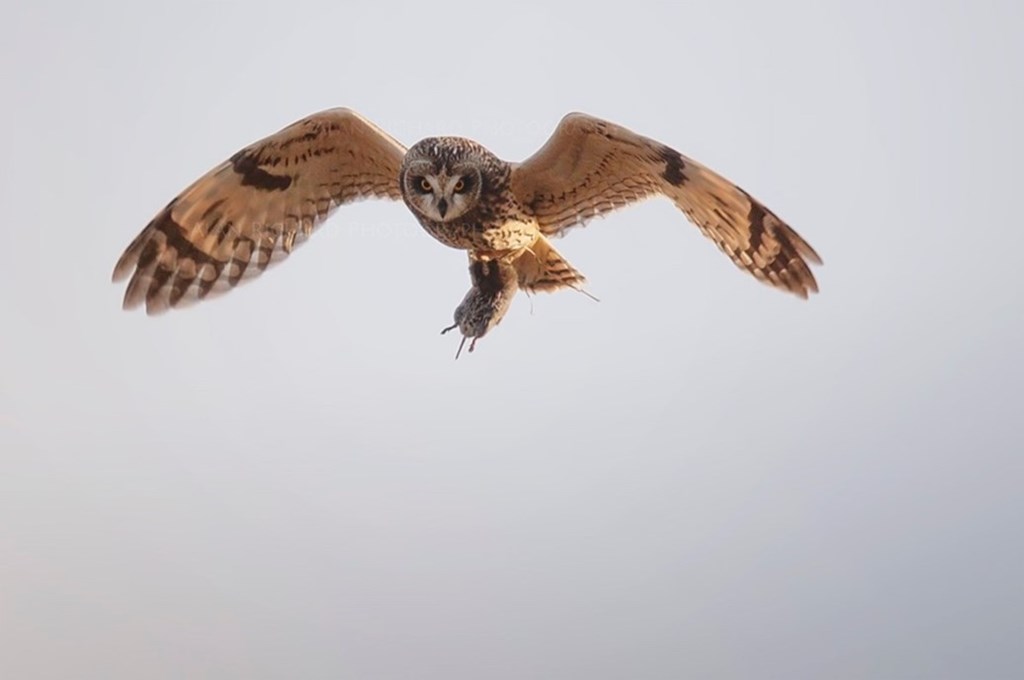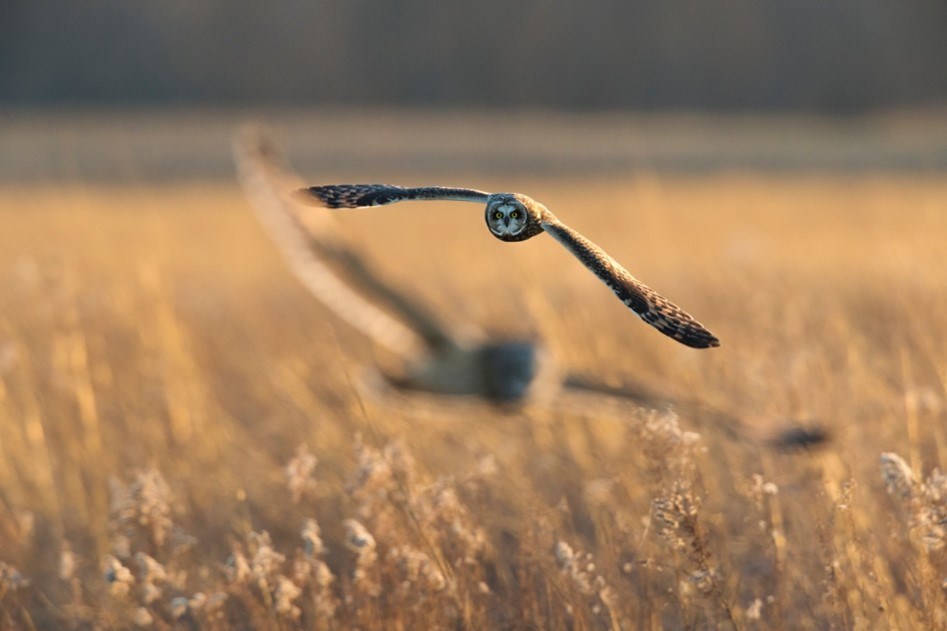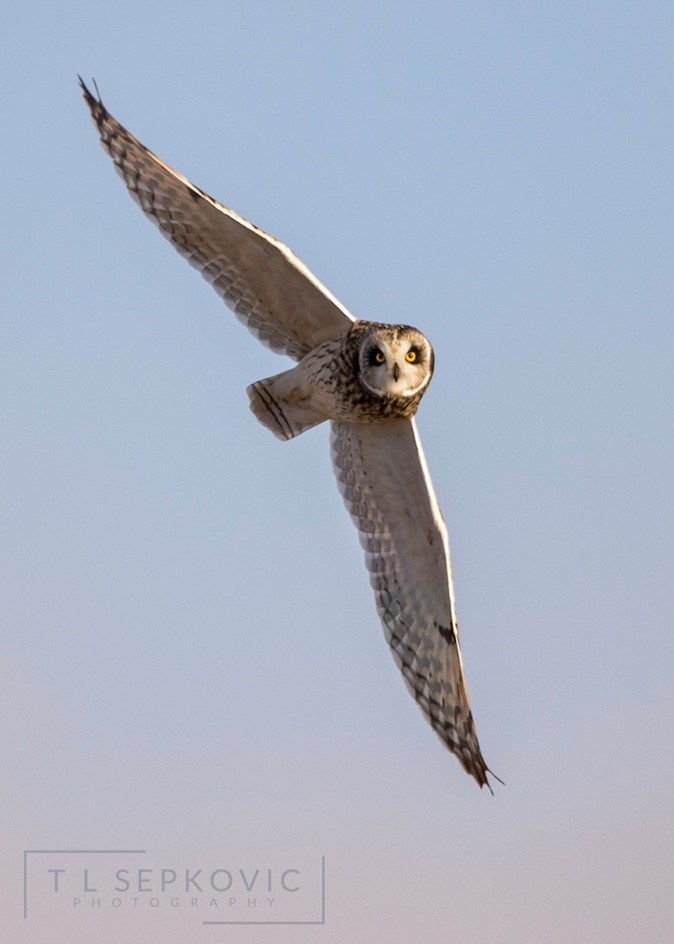Short-eared Owl
Asio flammeus

Name
The genus name Asio is Latin for “a horned owl.” The species name flammeus is Latin for “fiery” or flame-colored,” referring to this owl’s plumage. The common name reflects their short ear tufts (relative to the long-eared owl).
General Description
Short-eared owls are streaky, yellow-eyed owls with the appearance of a round head. Their coloring successfully mirrors that of the grassland vegetation they live amongst, and their overall plumage impression is golden, brown, and cream. Males are generally less colorful than the females, though this is not a hard and fast rule. They can be seen prowling over grasslands, marshes, and open fields at dawn, dusk, and during the day. In flight they have a characteristically light, moth-like wingbeat, and hold their wings in a slight “V” above their head, called a dihedral.
Similar species: Long-eared and barn owls can be confused with short-eared owls in flight. Long-eared owls do not show as clear of a dihedral, appearing flatter in profile when they fly, and they have mottling on their underside rather than streaking like the short-eared owl. Barn owls have comparatively little markings on their undersides, and they lack the dark wrist markings of the short-eared owl.
Fun Facts
• Short-eared owls are one of the only owls in the world to construct a nest.
• The short-eared owl is one of the most widely distributed raptors and is represented by several subspecies worldwide, most of which are island endemics; they are the only owl species in Hawaii (known locally as the Pueo).
• Short-eared owls sometimes roost communally in the winter.
Size
| Females | Males | |
| Wingspan | 90-100 cm (35-40 in.) ✏️✏️✏️✏️✏️ 5 pencils end-to-end | Same |
| Mass | 309 g (10.9 oz) 🍋🍋🍋 Nearly 3 lemons | 261 g (9.2 oz) 🍋🍋 Slightly over 2 lemons |
Vocals
Long-eared owls are hooting owls. Males give a series of hoots during territorial displays and courtship. They often give this call in flight, but will also hoot while perched, inflating the skin and feathers of the throat. Females respond to males with a “keee-ow” call, a vocalization also used when they feel threatened. Barks, squawks, hisses, and beak snaps are all part of the short-eared owls communication repertoire and are made by both sexes. Barks can be heard year-round. Juveniles make hissing, screaming begging calls.

Habitat
The short-eared owl is an open-habitat species. During the winter this includes fallow fields, hay meadows, pastures, marshes, and other sites that offer adequate shelter from the elements and freedom from human disturbance. In the summer they can be found breeding in a wide variety of habitats, including prairies, tundra, grasslands, marshes, and dunes. During the breeding season short-eared owls prioritize sites that offer optimal hunting opportunities, quality nesting habitat, and sufficient places to rest. Summer sites that offer year-round resources may double as an overwintering ground and vice versa.
Feeding
Short-eared owls are mammal specialists. A review of 10,000 pellets collected through 25 different studies in various locations revealed that mammals composed 94.8% of the identified prey, with Microtus voles making up more than 60% of that mammalian subset. Short-eared owls can take non-typical prey when necessary such as young muskrats, rabbits, and insects. Short-eared owls that live in places with an absence of voles have alternative diets; for example, coastal-dwelling populations feed on a high proportion of shorebirds, seabirds, and other marine-based prey, while short-eared owls in Ireland feed primarily on wood mice and brown rats, as voles are scarce.
Typical feeding behavior consists of flying less than two meters above the vegetation and angling into the wind to take advantage of lift. Short-eared owls are highly maneuverable, capable of turning on a dime and hovering directly above prey before attacking. Their long broad wings and slight dihedral allow them to remain airborne for long periods of time as they sweep over open fields in search of prey.

Nesting
Short-eared owl courtship is a breathtaking scene to witness, complete with impressive flights and auditory adornments to boot. The male will flap his way up to a desired height and then drop like a stone while bringing his wings together rapidly to produce a loud clapping sound while also hooting. Males will repeat this dance many times, sometimes performing for over an hour.
Short-eared owls are ground nesters, and one of the few owls to construct their own nest. The female will create or find a shallow depression in the ground and line it with grasses, feathers, or other suitable materials. Clutch size ranges from 1 to 11 eggs, with specific averages varying with latitude and prey abundance. Incubation and brooding are completed by the female while she and the nestlings are fed by the male. Incubation lasts roughly 21-31 days, and growth is rapid with fledging occurring at just 12-14 days of age. The young owls will scatter throughout their parent’s territory, therefore increases the probability of survival for at least some of the brood. Parents play an active role in harassing intruders by dive-bombing or pretending to have a broken wing so as to distract predators away from their vulnerable offspring.
Short-eared owls, like barn owls, are capable of double clutching if the first clutch fails and have even been documented raising two successful broods in one year. However, even with such adaptive breeding habits, short-eared owls have fairly low reproductive success primarily because their ground-nesting habits put them at risk for predation and human disturbance from some agricultural practices.
Migration
There is still a great deal to be learned about the movement ecology of short-eared owls. Experts agree that most populations likely migrate, however the details are poorly understood. Based on movement studies conducted thus far, short-eared owls display a combination of site fidelity (returning to the same sites year after year) and nomadism, suggesting that this is a species with flexible movement patterns. This could be due to the cyclical population fluctuations of voles, as some other species dependent on cyclical rodents such as snowy owls exhibit similar adaptability. Short-eared owls can be seen year-round in a horizontal strip across the northern United States, because of overlap between summering and wintering grounds.

Current Conservation Status
Short-eared owls are experiencing a decline across North America, although globally, given their wide range, they are listed as a species of least concern. Habitat loss seems to be the primary threat, and here in Pennsylvania, shifting agricultural practices and increased development have severely reduced the available habitat for ground-nesting birds. Like barn owls, kestrels, and northern harriers, short-eared owls require open habitats that host a diversity of vegetation rather than monoculture croplands. Monoculture is the cultivation of one crop on the same land, year after year, a practice that causes the soil to stagnate and stunts biodiversity. The number of different plants in an ecosystem is directly related to the number of species that can be found there, and while short-eared owls are rodent specialists, they still rely upon a healthy and biodiverse food web to ensure that they will have enough sustenance for themselves and their offspring.
Further back in the short-eared owl’s history, their strategy of high reproductive output during booming rodent years likely paid off over the long haul, allowing their populations to remain stable. However, now that many large tracts of once-inhabitable land have been degraded, their strategy may not be enough. Even if short-eared owls can lay 11 eggs during abundant vole years, those 11 hatchlings are not ensured ample resources for the entirety of their lives if the available habitat is in poor condition.
As rodent specialists, short-eared owls are valuable members of a healthy ecosystem and, as is true, for all raptors, they are bioindicators. This means they offer us a bar with which to measure the health of the environment. If short-eared owls are thriving, there must therefore be a healthy ecosystem supporting them. It’s all connected, and short-eared owls are a part of the web.
How can you help short-eared owls?
If you are a landowner, you can help short-eared owls by welcoming them as pest managers. This means that instead of relying on rodenticides, which are extremely harmful to raptors including short-eared owls, you and your community can support habitat features that attract short-eared owls and through these actions, increase rodent control on your land. Encouraging rotating crop cycles, creating edge habits, halting the use of rodenticides, avoiding activities that could destroy ground nests during breeding season, supporting short-eared owl research, and reporting sightings are just some of the potent ways you can help these beautiful birds. There are also cash incentives for landowners that support wildlife improvement areas through a project called the Conservation Reserve Enhancement Program (CREP). To learn more about these potential actions click here and/or contact Dr. Laurie Goodrich, the Sarkis Acopian Director of Conservation Science at Hawk Mountain: [email protected].
To support research on short-eared owls, contact our Senior Scientist Dr. JF Therrien at [email protected].
For information on Hawk Mountain’s Farmland Raptor Project, aimed at ensuring that barn owls and other grassland raptor species will continue to grace surrounding landscapes, click here.
If you are not a landowner, you can still help short-eared owls by spreading the word, supporting research, reporting sightings, and encouraging your community to protect and cultivate tracts of healthy open habitat.
Special thanks to Alan Richard, Traci Sepkovic, and Chris Brinkman for their generous photo contributions to this account.
Information written and compiled by Zoey Greenberg.
Sources
Cornell Lab of Ornithology. (2019). All About Birds: Short-eared Owl. Retrieved from
https://www.allaboutbirds.org/guide/Short-eared_Owl/maps-range
Johnsgard, P. A. (1988). North American owls: biology and natural history. Washington, D.C.: Smithsonian Institution Press.
Weidensaul, Scott. (2015). Owls of North America and the Caribbean. New York: NY.: Peterson Field Guides.